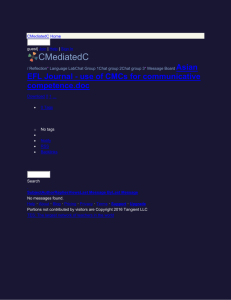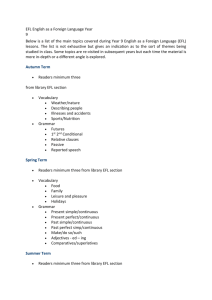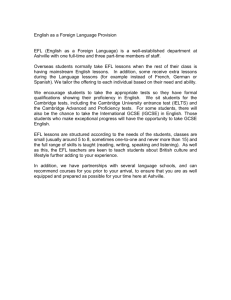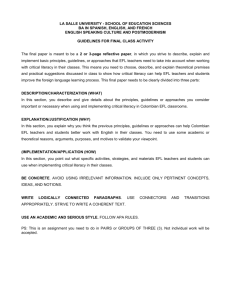An Empirical Study of Blog-assisted EFL Process Writing
advertisement
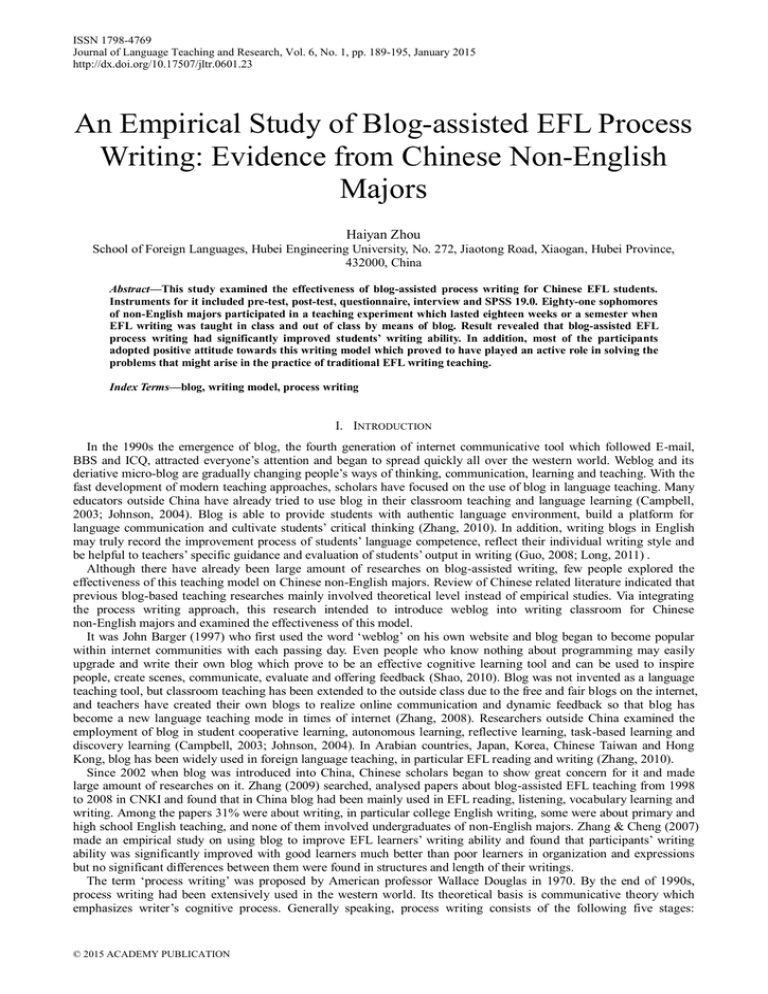
ISSN 1798-4769 Journal of Language Teaching and Research, Vol. 6, No. 1, pp. 189-195, January 2015 http://dx.doi.org/10.17507/jltr.0601.23 An Empirical Study of Blog-assisted EFL Process Writing: Evidence from Chinese Non-English Majors Haiyan Zhou School of Foreign Languages, Hubei Engineering University, No. 272, Jiaotong Road, Xiaogan, Hubei Province, 432000, China Abstract—This study examined the effectiveness of blog-assisted process writing for Chinese EFL students. Instruments for it included pre-test, post-test, questionnaire, interview and SPSS 19.0. Eighty-one sophomores of non-English majors participated in a teaching experiment which lasted eighteen weeks or a semester when EFL writing was taught in class and out of class by means of blog. Result revealed that blog-assisted EFL process writing had significantly improved students’ writing ability. In addition, most of the participants adopted positive attitude towards this writing model which proved to have played an active role in solving the problems that might arise in the practice of traditional EFL writing teaching. Index Terms—blog, writing model, process writing I. INTRODUCTION In the 1990s the emergence of blog, the fourth generation of internet communicative tool which followed E-mail, BBS and ICQ, attracted everyone’s attention and began to spread quickly all over the western world. Weblog and its deriative micro-blog are gradually changing people’s ways of thinking, communication, learning and teaching. With the fast development of modern teaching approaches, scholars have focused on the use of blog in language teaching. Many educators outside China have already tried to use blog in their classroom teaching and language learning (Campbell, 2003; Johnson, 2004). Blog is able to provide students with authentic language environment, build a platform for language communication and cultivate students’ critical thinking (Zhang, 2010). In addition, writing blogs in English may truly record the improvement process of students’ language competence, reflect their individual writing style and be helpful to teachers’ specific guidance and evaluation of students’ output in writing (Guo, 2008; Long, 2011) . Although there have already been large amount of researches on blog-assisted writing, few people explored the effectiveness of this teaching model on Chinese non-English majors. Review of Chinese related literature indicated that previous blog-based teaching researches mainly involved theoretical level instead of empirical studies. Via integrating the process writing approach, this research intended to introduce weblog into writing classroom for Chinese non-English majors and examined the effectiveness of this model. It was John Barger (1997) who first used the word ‘weblog’ on his own website and blog began to become popular within internet communities with each passing day. Even people who know nothing about programming may easily upgrade and write their own blog which prove to be an effective cognitive learning tool and can be used to inspire people, create scenes, communicate, evaluate and offering feedback (Shao, 2010). Blog was not invented as a language teaching tool, but classroom teaching has been extended to the outside class due to the free and fair blogs on the internet, and teachers have created their own blogs to realize online communication and dynamic feedback so that blog has become a new language teaching mode in times of internet (Zhang, 2008). Researchers outside China examined the employment of blog in student cooperative learning, autonomous learning, reflective learning, task-based learning and discovery learning (Campbell, 2003; Johnson, 2004). In Arabian countries, Japan, Korea, Chinese Taiwan and Hong Kong, blog has been widely used in foreign language teaching, in particular EFL reading and writing (Zhang, 2010). Since 2002 when blog was introduced into China, Chinese scholars began to show great concern for it and made large amount of researches on it. Zhang (2009) searched, analysed papers about blog-assisted EFL teaching from 1998 to 2008 in CNKI and found that in China blog had been mainly used in EFL reading, listening, vocabulary learning and writing. Among the papers 31% were about writing, in particular college English writing, some were about primary and high school English teaching, and none of them involved undergraduates of non-English majors. Zhang & Cheng (2007) made an empirical study on using blog to improve EFL learners’ writing ability and found that participants’ writing ability was significantly improved with good learners much better than poor learners in organization and expressions but no significant differences between them were found in structures and length of their writings. The term ‘process writing’ was proposed by American professor Wallace Douglas in 1970. By the end of 1990s, process writing had been extensively used in the western world. Its theoretical basis is communicative theory which emphasizes writer’s cognitive process. Generally speaking, process writing consists of the following five stages: © 2015 ACADEMY PUBLICATION 190 JOURNAL OF LANGUAGE TEACHING AND RESEARCH prewriting, rough draft, feedback, revising and rewriting. Tribble (1996) proposed a four-stage model: prewriting rehearsing, drafting composing, revising and editing. Similarly, Hu (2003) divided process writing into four phases: preparation, drafting, revising and sharing with peers. Compared with the traditional writing approach which emphasizes writing format and sentence patterns, process writing focuses on pre-thinking and discussion before writing, revising and sharing after writing. The integration of weblog with process writing not only plays the role of blog as an internet communicative tool, but also reveals the advantages of process writing. Figure 1 Blog-assisted Process Writing Model This research introduced process writing into Chinese undergraduates’ EFL classroom writing (see figure 1 for the proposed blog-assisted process writing model). Under the guidance of teacher, students created their own blogs and invited their teacher as well as classmates to add as friends, thus creating an online communicative platform which could be used for blog-assisted classroom writing. In the whole teaching process, teacher offered guidance, monitoring and feedback while students practiced cooperative learning, autonomous writing and evaluated others’ writings. II. METHODS A. Purpose and Participants The purpose of this research intended to validate the effectiveness of weblog-assisted process writing on Chinese undergraduates of non-English majors and also examine participants’ attitude towards this writing model. Participants were eighty-one sophomores of non-English majors from Hubei Engineering University, China. Among them 45 were females and 36 males with the age of 18-22. The students were randomly divided into experiment class (40 students) and control class (41 students). B. Instruments Instruments for this research included pre-test, post-test, questionnaire, interview and SPSS 19.0. The title for pre-test was ‘Food and Health’ while for post-test it was ‘On the Essential Responsibility of a University Professor’. Each student’s compositions were scored by three experienced teachers according to CET scoring criteria. The mean score of the three was the final score. The Kendall concordance coefficients for the pretest were respectively 0.815, 0.793 and 0.806, and for the posttest they were 0.794, 0.813 and 0.824, indicating the acceptable high reliability. The author of this paper analysed the literature with respect to weblog-assisted EFL writing, referred to others’ questionnaires, listened to some college teachers’ suggestions and proposals and designed a questionnaire which was composed of 30 items, covering students’ internet knowledge and levels (item 1-8), students’ recognition of blog-assisted writing model (item 9-14) and their evaluation of teaching effectiveness for writing (item 15-30). The questionnaires were distributed to students from experiment class immediately after the post-test, students were informed of the research purpose and expected to honestly answer the questions. SPSS 19.0 was employed to analyse and validate the data collected. Result indicated that the Alpha coefficient for the questionnaire was 0.843. After the experiment, some of the students from the experiment class were interviewed for their recognition of and attitude towards the new writing model. C. Procedure Process writing theory divides blog-assisted EFL writing into four teaching phases (see figure 2): preparation phase, outline-draft phase, modification phase and final draft phase. Students from experiment class were randomly divided into groups of 5-6 persons so as to have class discussions and © 2015 ACADEMY PUBLICATION JOURNAL OF LANGUAGE TEACHING AND RESEARCH 191 after-class cooperative learning. Topics were given to students ahead of time and students were required to search the related material before class for the class discussions. Group leader was elected for each group, a recorder was in charge of the outlines and key materials and a reporter handed in the discussion report. Teacher evaluated and scored the reports and group assignments, group members held the post of group leaders, recorders and reporters in turn so that each student could actively participate in the class activities. 1. Preparation phase Writing teaching was conducted via the weblog platform as well as the traditional classroom. Teacher used blog to assign homework and topics to be discussed in class, informed students of the requirements and demanded that they write down any ideas related to the topics and discuss them with the group members through brainstorm. Based on the discussion result, students created a vocabulary figure, connected and reorganized the related information to prepare for the next stage in terms of vocabulary and way of thinking . Then teacher encouraged students to search the relevant articles and books on the given topics through the internet or library so as to know more about them and issue the good articles on their personal blogs to share them with other students. Students were required to integrate the materials collected and write of their own will through weblog and share their writings with other students for the sake of reading and comments which might help students narrow the scope of topics. Those who made comments about others’ writings also benefited from them. 2. Outline-draft phase Having been prepared for vocabulary, searched the relevant information and discussed about the given topic, students were required to finish their outlines and drafts within the deadline, release them on their own blogs, made comments on their classmates’ outlines and drafts, evaluate and revise them so as to help each other, in particular among the group members themselves. During this stage, the main role of the teacher was to supervise students to finish the tasks and offer them guidance in time. Figure 2 Blog-assisted EFL Process Writing 3. Modification phase Modification was made through three means: (1) Peer-review. Each student released his/her own draft, reviewed at least 5 other drafts simultaneously, read them carefully and pointed out their merits and drawbacks so as to help improve them; (2) Teacher review. Influenced by Chinese traditional education, students seem to be more convinced of teacher’s comments. Hence it is a must that teachers review all the drafts. Teacher read students’ drafts carefully and assessed them in terms of contents, structures and vocabulary and released her comments via blog for students’ reference; (3) Others review. As the weblog platform in this research was open, any web user might visit, and leave messages and review students’ writings. It was noted that the percentage of this sort of review was fairly low in the whole teaching process. 4. Final draft phase After students modified their writings according to their classmates’ comments and teacher’s suggestions, they released the final drafts via weblog for the re-review of the teacher and other students. Then some remarkable writings were chosen for teacher’s evaluation. Finally the teacher summarized the whole writing teaching, pointed out the achievements that had been made and problems to be solved for the reference of next writing teaching. © 2015 ACADEMY PUBLICATION 192 JOURNAL OF LANGUAGE TEACHING AND RESEARCH III. RESULTS AND DISCUSSION During the 18 week blog-assisted EFL process writing, internet-assisted EFL writing platform was built. The teacher released 124 copies of teaching material in total and students released 12 final drafts of writing per person, 482 copies in total. Teacher corrected 36 in total, received and replied to 208 questions; students peer-reviewed 285 writings and the visit count of teacher’s weblog exceeded 15,000. A. Effectiveness in Improving Students’ Writing Ability SPSS 19.0 was employed to analyse the results of the pre-test and the post-test and compared the differences between the experiment class and controlled class before and after the teaching experiment. The purpose of the pre-test was to become acquainted with students’ writing levels for the reference of the coming weblog-assisted EFL process writing. See table 1 for statistics of pre-test. The mean score for controlled class was 68.324 7, higher than that of experiment class whose mean score was 67.947 9. The standard deviation for the former was 10.732 97 and for the latter it was 10.394 68 (see table 1). Experiment class Controlled class TABLE 1 STATISTICS FOR PRE-TEST Minimum Maximum 48.00 85.00 45.00 87.00 N 40 41 Mean 67.9479 68.3247 Std. Deviation 10.394 68 10.732 97 TABLE 2 INDEPENDENT SAMPLE T TEST FOR PRE-TEST Levene’s Test for Equality of T-Test for Equality of Means variances F Sig. t df Sig. Mean Std. Error (2-tailed) Difference Difference Equal variance assumed Equal variance not assumed 0.08 .926 .156 .156 77 76.997 .875 .875 .381 17 .381 17 2.408 96 2.408 96 95% Confidence Interval of the Difference Upper Lower -4.415 69 5.178 04 -4.413 73 5.176 07 Independent sample t test (ɑ=0.05, sig=0.926, p>ɑ) indicated that there was no significant difference between the two classes for the pre-test results and that students from the two classes were at about the same level of writing (see table 2). After 18 week’s teaching of blog-assisted process writing, the two classes had a post-test. For the post-test results see table 3. Compared table 1 and table 3, it could be clearly seen that both classes obtained higher scores for their post-test than pre-test and that the experiment class made significantly greater progress than the controlled one (75.1815-67.947 9=7.233 6; 70.975 0-68.324 7=2.641 1; P<0.05). In addition, it should be noted that the maximums of both classes also increased significantly with the experiment class from 85 to 95 and the controlled class from 87 to 97. Experiment class Controlled class TABLE 3 STATISTICS FOR POST-TEST Minimum Maximum Mean 53.00 95.00 75.181 5 40.00 97.00 70.965 8 N 40 41 Std. Deviation 10.954 32 16.289 74 TABLE 4 INDEPENDENT SAMPLE T TEST FOR POST-TEST Levene’s Test for Equality of variances T-Test for Equality of Means F Sig. t df Sig. Mean Std. Error (2-tailed) Difference Difference Equal variance assumed Equal variance not assumed 4.268 .042 -1.343 77 .183 -4.204 49 3.131 31 95 Confidence Interval of the Difference Lower Upper -10.439 72 2.030 75 -1.349 68.453 .182 -4.204 49 3.116 20 -10.422 02 2.013 05 Result of independent sample t test for post-test (sig.=0.042<0.05) indicated that there was significant difference between the two classes (see table 4). In consideration of the equality in the pretest result, it can be concluded that blog-assisted process writing has significantly improved the writing ability of students from the experiment class. B. Students’ Attitude towards Blog-assisted EFL Writing Model When the 18 week blog-assisted process writing teaching ended, questionnaires were released to investigate students’ recognition of blog-assisted EFL writing model. Results revealed that 32 of the 40 students (80%) believed that weblog-assisted EFL writing teaching was superior to the traditional teaching method, only one (2.5%) was opposed to the new method and seven (17.5%) were not sure. As for the degree at which the model was welcome, 67.5% chose ‘like’, 2.5% chose ‘unlike’ and 30% ‘neutral’. For the active degree of students’ participation, 65% chose ‘very active’, 5% chose ‘not very active’ and 30% were ‘not sure’. For the question whether webog could provide authentic language © 2015 ACADEMY PUBLICATION JOURNAL OF LANGUAGE TEACHING AND RESEARCH 193 environment, 70% students chose ‘yes’, 7.5% chose ‘no’ and 22.5% were’ not sure’. Among the scores for questionnaire, the first ten items can be seen in table 5, indicating that the means for these items were all above 4 and also the high recognition of the new writing model (4 for ‘agree’ and 5 for ‘quite agree’). Most of the participants believed that blog-assisted writing teaching might ‘improve their application ability of computers’ with mean of 4.426 7 at the top of the rank; ‘Improving students’ writing level’ was second with mean score 4.3600, indicating participants’ approval of the effectiveness of bog-assisted EFL writing. Students in general thought that the teaching stage of curriculum design, in particular group activities might cultivate team cooperation awareness. At the same time most of the participants approved the scientificity of curriculum design and evaluative system (see items which rank 4, 8 and 10 in table 5). As for the teaching effectiveness, students mostly believed that blog-assisted process writing mode increased their interest and confidence in EFL writing and improved their writing level. TABLE 5 STATISTICS FOR Q UESTIONNAIRE Minimum Maximum The model improves application ability of computers. The new model improves students’ writing level. Group discussion cultivates students’ cooperative learning competence. Curriculum design is reasonable and scientific. The model decreases fear of writing and increases students’ confidence in EFL learning. Teacher and peer review increases students’ interest in writing. Blog-assisted writing teaching is more effective than the traditional one. Course objective is clear. Blog release may arouse students’ writing motivation. Evaluation criteria is reasonable and scientific. Mean 2.00 2.00 2.00 5.00 5.00 5.00 4.4267 4.3600 4.3333 Standard Deviation .73839 .70978 .74132 Rank 2.00 2.00 5.00 5.00 4.2800 4.2000 .66900 .76335 4 5 2.00 2.00 5.00 5.00 4.2000 4.1733 .73521 .69749 6 7 2.00 2.00 1.00 5.00 5.00 5.00 4.1600 4.1067 .66522 .78912 .74568 8 9 10 1 2 3 C. Summarization of Interview When post-test ended, 15 students from the experiment class were randomly chosen to be interviewed mainly on three questions: (1) What do you think of blog-assisted process writing teaching mode? (2) In what aspect have you made progress via this teaching mode? (3) What suggestions do you have for the improvement of the blog-assisted process writing mode? The students interviewed all gave active response to the questions. 93.3% of them recognized the new teaching mode, which conformed to the statistic data collected from questionnaires. Interview results can be interpreted from the following four aspects. Firstly, according to the statistics for questionnaires, students have made significant progress in writing, learnt a large number of new words and phrases. Before the experiment, participants did not know enough about the application of computer and began to make use of computers and internet after the writing course, which enriched their way of daily life and learning. Secondly, blog and writing group created a platform through which students communicated with each other. Participants observed that via the platform they might learn from each other, cooperate with each other and expressed their own ideas. Brainstorm and group discussion aroused students’ interest and improved their writing ability. Thirdly, students’ attitude towards writing course changed a great deal. Some students claimed that they had disliked the course before the experiment. After one semester of blog-assisted progress writing, however, they had begun to like the course, reading and updating blogs had become one part of their daily life. This autonomous learning via the internet with clear objective had greatly improved their learning efficiency. Many students admitted that previously they had wandered on the net here and there, and that since the teaching experiment, their online activities had become full and meaningful, which aroused their enthusiasm in EFL reading and writing on the internet. Fourthly, students’ confidence has been increased. Previously some students did not dare to express their ideas to others. Now the desire to express themselves has become exceedingly strong, in particular when they have been fully prepared ahead of time. Students liked the stage of blog evaluation, thinking that reading others’ comments on their writings was a great pleasure as well as valuable help to the improvement of their writing level. IV. CONCLUSION AND SUGGESTIONS A. Conclusion Statistics about the tests and questionnaires, and summarization of interview reveal that the blog-assisted process writing teaching mode is able to improve the writing ability of Chinese students of non-English majors in the following three aspects. Firstly, blog-assisted process writing has proved to be helpful to the dynamic evaluation of students’ writings. Dynamic evaluation might provide effective guidance for students in terms of writing strategies, resources and encouragement, timely reflect the effectiveness of teacher’s guidance, promotes good interaction between the teacher © 2015 ACADEMY PUBLICATION 194 JOURNAL OF LANGUAGE TEACHING AND RESEARCH and students and also between students themselves so as to improve students’ level of EFL writing. The weblog platform facilitated dynamic evaluation. Feedback from teacher and students made it easy for students to know their merits and drawbacks. At the same time teacher’s monitoring and students’ awareness of competition might also effectively motivate students’ active modification of their drafts. Secondly, the active participation of students and teacher in the process writing has improved students’ meta-cognitive ability and EFL writing level. Blog-assisted process writing teaching mode provides students with scientific writing strategies. Via this mode, students became clearer about their writing objective and more aware of the various writing stages. The pre-discussion, brainstorm and group cooperation widened students’ vision and thinking, enriched their writing contents. Obviously preparations might solve the problem of Chinese students’ ‘having nothing to say for their writing’. Thirdly, blog-assisted process writing has facilitated reflective teaching. Each of students’ draft was recorded in the blog and after they had finished writing, students might have reflections about the whole writing process from beginning to the end. Hence compared with the traditional teaching mode, the new mode makes reflective learning more possible. Simultaneously, teacher and students might interact with each other on the blog platform, in particular at the modification stage when students might improve their way of expression and decrease grammatical mistakes with the help of teacher and peer feedback. Blog-assisted process writing also offered students more opportunities to strengthen their writing strategies. B. Suggestions The 18 week teaching experiment has proved that blog-assisted process writing mode may effectively improve participants’ writing ability. It is noted that there are also some limitations for this research. Firstly, participants came from the same university and the sample was somewhat small. Hence whether the conclusion arrived at can be universally used is to be validated. It is suggested that larger and more representative sample (from different universities in different countries) should be chosen for further research to examine more widely and in an all-round way the effectiveness of blog-assisted process writing upon EFL learners. Secondly, limited by time and large class size, one-for-one evaluation was impossible and more often teacher had to choose one or two of the writings and made comments on them. In the process writing teaching, face-to-face discussion between teacher and students is also an effective form of teacher evaluation and can make up for the drawbacks of teacher’s one way written feedback. Thirdly, the duration of experiment was merely 18 weeks which might be insufficient for the fundamental influence on participants EFL writing ability. Hence it is suggested that long and systematic blog-assisted process writing experiment should be made to validate the effectiveness of the mode and its durable affect on students’ writing strategies. Fourthly, the free casual way of blog writing and the open environments of blog platform have also brought some negative impact. Some students used non-standardized expressions in their writing such as BTW (by the way) and U (you). Comments on some writings were mixed up with irrelevant comments or advertisements and even some criticism with malice, which is one of the factors to be taken into consideration in future blog-assisted process writing. As it is a must that teacher interfere with the blog-assisted process writing teaching, it is suggested that teacher is supposed to know more about the relevant knowledge with respect to the process writing teaching so as to help students acquire and efficiently use this effective writing strategy. In addition, teacher should guide the students as to how to select appropriate material from the vast information on the internet. Many students believed that they had benefited a great deal from the internet information. Nevertheless, some students complained that it usually took them lots of time and energy to find the material needed. Therefore it is suggested that teacher should make every effort to find more effective ways that may help increase students’ online researches. To sum up, blog-assisted process writing teaching mode does help students overcome some of the the difficulties in their EFL writing. Students indeed benefit a great deal from the stages of free writing, brainstorm, group discussion and peer review. Their anxiety about EFL writing has been decreased and confidence in writing increased. However, there are still some issues for further research and discussion. For example, should students persist in blog-assisted writing after the writing course ended? How can the teacher effectively monitor and evaluate students’ online writing? REFERENCES [1] [2] [3] [4] [5] [6] [7] [8] [9] Combell, A. P. (2003). Weblogs: A history and perspective. In Editors of Persus Publishing (Eds.). We’ve Got Blog: How Weblogs Are Changing Culture (pp.7-16). Cambridge, MA; Persus Publishing. Guo, X.Y. (2008). Teaching of College English Writing Based on Blog. Journal of Zhongshan University, (6), 34-39. Hu, X. Y. (2003). Process writing and its application. Foreign Languages and Their Teaching, (9), 21-28. Johnson, A. (2004). Creating a writing course utilizing class and student blogs. The Internet TESL Journal <http://iteslj. org/Techniques/ Johnson-Blogs>, 10(8), 32-45. Long, L. (2011). The role of blog interaction in writing teaching for English majors. Science and Technology Information, (4), 32-34. Shao, Z.F. (2010). Application of blog in task-based EFL teachin. Journal of Hetian Normal University, (5), 43-46. Tribble, C. (1996). Writing. London: Oxford University Press. Zhang, Y.H. (2008). Dynamic assessment mode for online EFL Writing. Foreign Language world, (4), 56-62. Zhang, Y.H. & Cheng, D.Y. (2007). The Design and Operation of College English Writing Teaching Mode in Online © 2015 ACADEMY PUBLICATION JOURNAL OF LANGUAGE TEACHING AND RESEARCH 195 Environment. Computer-assisted Foreign Language Teaching, (5), 32-37. [10] Zhang, Z. (2005). Application of blog in College English. Journal of Hunan University, (3), 45-47. [11] Zhang, Z. & Li, L. X. (2009). Review of China’s weblog-assisted EFL teaching. Language Teaching Research, (5), 72-77. Haiyan Zhou was born in Jingshan, Hubei, China in 1979. She received her master degree in English curriculum and teaching theory from Hubei University in 2008. She is currently a lecturer in the School of Foreign Languages, Hubei Engineering University, Xiaogan, Hubei, China. Her research interests include second language acquisition and English teaching. © 2015 ACADEMY PUBLICATION
